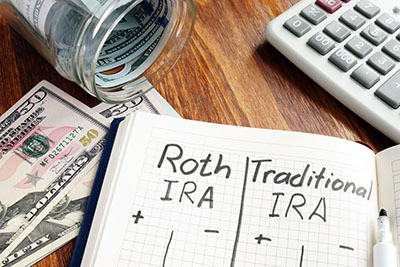 Contact
About Us
Articles
Home
Contact
About Us
Articles
Home

You’ve probably made a few transitions in your life, but going from full-time employment into part-time employment or retirement is one of the biggest. In addition to deciding what you will do with all those hours that you won’t be devoting to your full-time career, you’ll need to figure out how to use your financial resources to supplement your income.
If you’re like most retirement savers, you have your money in several different types of accounts such as:
You’re likely concerned about using the best strategy for withdrawing these funds: Which of them should you tap first? What’s the most tax-efficient approach for liquidating your nest egg? Should you first take money from your traditional IRA or your Roth IRA?
Like most things in your financial life, there is no one-size-fits-all tactic to answer all of your questions. But there are some very important things to consider as you make these decisions.
There are general guidelines that most financial professionals believe will work for the majority of new retirees. Keep in mind that there might be exceptions to this order of withdrawal in your specific situation. The rationale for this order is to minimize and defer taxes, but it could also have an impact on the growth and sustainability of your retirement portfolio:
First, you should consider your streams of income to help you determine how much to take from your investments. Keep in mind that waiting until your full retirement age or longer to collect Social Security makes sense if you can afford to live without it since you’ll get a larger monthly check later. But if you choose to take it sooner, count it among your streams of income.
If your income streams don’t meet your retirement needs, you should make up the deficit with withdrawals from your taxable investments. You might realize capital gains on these funds, but the tax rate on them is typically less than the income tax rate you would pay on traditional IRA withdrawals.
In most cases, you would not withdraw from tax-deferred accounts until you have depleted your taxable accounts so that you can delay paying taxes on them as long as possible and allow them to grow within the shelter of your qualified account.
But, as mentioned earlier, the order of withdrawals might not work out for you.

Let’s assume you retire at 62 years of age. Then, you would begin by liquidating your taxable accounts, moving on to your tax-deferred investments later. But keep in mind that starting in the year in which you turn 72 under the SECURE Act, you must withdraw a specific amount from your traditional IRA annually. The amount will be determined by the size of your account and your life expectancy.
If you retire at 72 or close to it, you’ll likely be taking money from your tax-deferred account before you deplete your taxable funds. In that case, take your required distribution and make up the difference from the taxable accounts.
Another consideration: If you retire in your early 60s with an IRA of high value, that account might grow to an amount that would cause you to take large RMDs, sending you into a higher tax bracket. If you have a sizable IRA balance at early retirement, it might make sense to withdraw a modest amount from your IRA account each year so that you won’t be hit with a big tax bill when you turn 72 and begin your RMDs.
While conventional wisdom indicates your order of withdrawals should end with Roth IRAs, other situations could change the standard order. RMDs and highly appreciated investments are the more common reasons, but there are other factors to think about:
If you have any of these atypical financial situations, it’s a good idea to talk to a financial advisor to help you come up with the best strategy.
One of the basic tenants of investing is to stay away from strategies that are designed solely to avoid or minimize taxes. More often, you’ll come out ahead by focusing on the best investments for your situation without obsessing over the tax implications.
But that isn’t to say that you shouldn’t have a strategy for liquidating those investments without paying more taxes than you need to. Here is one example of how you can make withdrawals and keep taxes at bay. Notice that it diverges from the typical withdrawal order.
Here is a newly retired couple who have accumulated $750,000. Approximately 60% of their investments are in tax-deferred accounts, 30% in Roth IRAs and 10% in taxable accounts. The couple wants to spend $65,000 annually, of which $29,000 will come from Social Security benefits. They will be withdrawing a little less than 5% of their savings each year to make up the difference.
Instead of employing the conventional method of using taxable investments first, they might consider using their lower tax bracket in retirement strategically by filling that bracket with ordinary income from tax-deferred distributions. If they need additional income, they can tap their taxable accounts and then withdraw from their Roth accounts. Here’s how it would look:
| Conventional Wisdom | Filling the Tax Bracket | |
|---|---|---|
| Account withdrawals | Conventional WisdomTaxable account: years 1 - 3 Tax-deferred: years 4 - 18 Roth IRA: years 19 - 30 |
Filling the Tax BracketTax-deferred distributions of $20,000 - $23,000 each year; supplement with taxable accounts (years 1 - 5) and Roth (years 6 - 30) |
| Federal taxes paid over 30 years | Conventional Wisdom$46,000 | Filling the Tax Bracket$0 or minimal amount |
| Longevity of portfolio | Conventional Wisdom29.2 years | Filling the Tax Bracket31.6 years |
As you approach retirement, here are some points to remember:
Alliance America is an insurance and financial services company. Our financial planners and retirement income certified professionals can assist you in maximizing your retirement resources and help you to achieve your future goals. We have access to an array of products and services, all focused on helping you enjoy the retirement lifestyle you want and deserve. You can request a no-cost, no-obligation consultation by calling (833) 219-6884 today.


